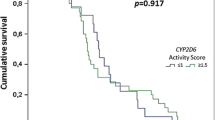Abstract
Objective
The determination of the prevalence of the CYP2C8 main alleles in a typical set of malaria patients in Zanzibar, as these patients represent a typical population exposed to amodiaquine, an antimalarial mainly metabolized by CYP2C8. Also, to determine for the first time the frequencies of CYP2C8 alleles in native African populations.
Methods
Polymerase chain reaction–restriction fragment polymorphism for the identification of CYP2C8*1, CYP2C8*2, CYP2C8*3 and CYP2C8*4 on a random population of 165 unrelated malaria patients.
Results
The allele frequencies found were: CYP2C8*1 (wild type, 83.4%), CYP2C8*2 (13.9%), CYP2C8*3 (2.1%) and CYP2C8*4 (0.6%). In terms of genotypes, 70.4% of the patients showed the CYP2C8*1/ CYP2C8*1 genotypes, while heterozygous between the wild type and other minor alleles were seen in 26.0%. Finally, 3.6% of the patients were homozygous for slow metabolizer alleles. The frequencies observed are equivalent to those documented for African-Americans.
Conclusions
CYP2C8 non-wild type alleles have a significant prevalence in the East African population studied. The consequent frequency of 3.6% of patients homozygous for slow metabolizer alleles represent a significant fraction of the population potentially in higher risk of adverse effects due to a less efficient metabolism of amodiaquine. As approximately 106 first-line treatments are currently performed in Zanzibar per year, this represents a non-negligible absolute number of amodiaquine exposures. This information constitutes a background for the pharmacovigilance programs presently being employed in Zanzibar.
Similar content being viewed by others
References
Björkman A (2002) Malaria associated anaemia, drug resistance and antimalarial combination therapy. Int J Parasitol 32:1637–1643
White NJ, Looareesuwan S, Edwards G, Phillips RE, Karbwang J, Nicholl DD, Bunch C, Warrell DA (1987) Pharmacokinetics of intravenous amodiaquine. Br J Clin Pharmacol 23:127–135
Winstanley P, Edwards G, Orme M, Breckenridge A (1987) The disposition of amodiaquine in man after oral administration. Br J Clin Pharmacol 23:1–7
Li XQ, Bjorkman A, Andersson TB, Ridderstrom M, Masimirembwa CM (2002) Amodiaquine clearance and its metabolism to N-desethylamodiaquine is mediated by CYP2C8: a new high affinity and turnover enzyme-specific probe substrate. J Pharmacol Exp Ther 300:399–407
Finta C, Zaphiropoulos PG (2000) The human CYP2C locus: a prototype for intergenic and exon repetition splicing events. Genomics 63:433–438
Dai D, Zeldin DC, Blaisdell JA, Chanas B, Coulter SJ, Ghanayem BI, Goldstein JA (2001) Polymorphisms in human CYP2C8 decrease metabolism of the anticancer drug paclitaxel and arachidonic acid. Pharmacogenetics 11:597–607
Bahadur N, Leathart JB, Mutch E, Steimel-Crespi D, Dunn SA, Gilissen R, Houdt JV, Hendrickx J, Mannens G, Bohets H, Williams FM, Armstrong M, Crespi CL, Daly AK (2002) CYP2C8 polymorphisms in Caucasians and their relationship with paclitaxel6alpha-hydroxylase activity in human liver microsomes. Biochem Pharmacol 6:1579–1589
Nakajima M, Fujiki Y, Noda K, Ohtsuka H, Ohkuni H, Kyo S, Inoue M, Kuroiwa Y, Yokoi T (2003) Genetic polymorphisms of CYP2C8 in Japanese population. Drug Metab Dispos 31:687–690
Anonymous (2002) Zanzibar Malaria Control Program. National Guidelines for malaria diagnosis and treatment in Zanzibar
Olliaro P, Nevill C, LeBras J, Ringwald P, Mussano P, Garner P, Brasseur P (1996) Systematic review of amodiaquine treatment in uncomplicated malaria. Lancet 348:1196–1201
Schwartz E, Pener H, Issa SM, Golenser J (1997) An overview of the malaria situation in Zanzibar. J Community Health 22:33–44
Gil JP, Nogueira F, Stromberg-Norklit J, Lindberg J, Carrolo M, Casimiro C, Lopes D, Arez AP, Cravo PV, Rosario VE (2003). Detection of atovaquone and Malarone resistance conferring mutations in Plasmodium falciparum cytochrome b gene (cytb). Mol Cell Probes 17:85–89
Gardner MJ, Altman DG (1989) Statistics with confidence—confidence intervals and statistical guidelines. BMJ Publishing, London
Pang T (2003) Impact of pharmacogenomics on neglected diseases of the developing world. Am J Pharmacogenomics 3:393–398
Weise A, Grundler S, Zaumsegel D, Klotzek M, Grondahl B, Forst T, Pfutzner A (2004). Development and evaluation of a rapid and reliable method for cytochrome P450 2C8 genotyping. Clin Lab 50:141–148
Garcia-Martin E, Martinez C, Tabares B, Frias J, Agundez JA (2004) Interindividual variability in ibuprofen pharmacokinetics is related to interaction of cytochrome P450 2C8 and 2C9 amino acid polymorphisms. Clin Pharmacol Ther 76:119–127
Mizutani T (2003) PM frequencies of major CYPs in Asians and Caucasians. Drug Metab Rev 35:99–106
Yasar U, Lundgren S, Eliasson E, Bennet A, Wiman B, de Faire U, Rane A (2002). Linkage between the CYP2C8 and CYP2C9 genetic polymorphisms. Biochem Biophys Res Commun 299:25–28
Scordo MG, Aklillu E, Yasar U, Dahl ML, Spina E, Ingelman-Sundberg M (2001) Genetic polymorphism of cytochrome P450 2C9 in a Caucasian and a black African population. Br J Clin Pharmacol 52:447–450
Allabi AC, Gala JL, Desager JP, Heusterspreute M, Horsmans Y (2003) Genetic polymorphisms of CYP2C9 and CYP2C19 in the Beninese and Belgian populations. Br J Clin Pharmacol 56:653–657
Jewell H, Maggs JL, Harrison AC, O’Neill PM, Ruscoe JE, Park BK (1995) Role of hepatic metabolism in the bioactivation and detoxification of amodiaquine. Xenobiotica 25:199–217
Clarke JB, Neftel K, Kitteringham NR, Park BK (1991) Detection of antidrug IgG antibodies in patients with adverse drug reactions to amodiaquine. Int Arch Allergy Appl Immunol 95:369–375
Tingle MD, Jewell H, Maggs JL, O’Neill PM, Park BK (1995) The bioactivation of amodiaquine by human polymorphonuclear leucocytes in vitro: chemical mechanisms and the effects of fluorine substitution. Biochem Pharmacol 50:1113–1119
Acknowledgements
I. Cavaco is the recipient of a grant from Fundacão para a Ciência e Tecnologia, Portugal; SFRH/BD/8887/2002. This work was partially supported by the Swedish International Development Cooperation Agency, Department for Research Cooperation (SIDA-SAREC) and by a Grant-in-aid for Research on International Medical Cooperation from the Ministry of Health, Labour and Welfare of Japan, Tokyo, Japan, by grant-in-aid for Scientific Research (13576030 and 14570224) from Ministry of Education, Culture, Sports, Science, and Technology of Japan, Tokyo, Japan.
Author information
Authors and Affiliations
Corresponding author
Rights and permissions
About this article
Cite this article
Cavaco, I., Strömberg-Nörklit, J., Kaneko, A. et al. CYP2C8 polymorphism frequencies among malaria patients in Zanzibar. Eur J Clin Pharmacol 61, 15–18 (2005). https://doi.org/10.1007/s00228-004-0871-8
Received:
Accepted:
Published:
Issue Date:
DOI: https://doi.org/10.1007/s00228-004-0871-8




